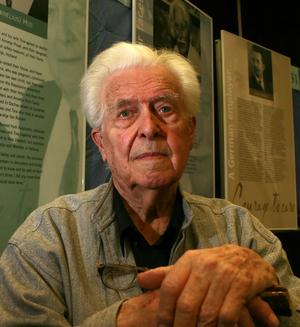Andrew Paul Wood – 23 December, 2015
The influence of New Vision on the Auckland art scene in the mid-sixties was phenomenal, and aside from exhibiting, the Hoses gave tremendous moral support and friendship to a number of artists, including Colin McCahon. They were a rare thing in those days, champions of modernism and abstraction, though not exclusively, and a point of contact with developments in Europe. They were, in many ways, the god parents of New Zealand modernist art.
Kees Hos obituary
Peter McLeavey was not the only important New Zealand gallerist to shuffle off the mortal coil this year. Kees (Cornelis) Hos (b 1916) passed away in Auckland on 3 December 2015. Hos was a young teacher at the Royal Academy of Art in The Hague when the Second World War broke out. He joined the Dutch underground resistance, hiding Jewish friends from the Academy and their families in his home, and forging passports and identification papers. Obviously this was not without risk to himself, his wife Tine and their young daughter Eske, and indeed he was eventually arrested, spending the end of the war in a Dutch prison. For this he would eventually receive a Medal of Honour from Israel, “righteous among the nations”.
In 1956 the family moved to New Zealand. Kees worked in an advertising firm, taught at Elam, and eventually the Hoses opened their New Vision Gallery in Takapuna. Named after Bauhausler László Moholy-Nagy’s influential book The New Vision, from Material to Architecture (1932), it specialised in local, high-end applied art and handcrafts. In early 1959 New Vision moved to His Majesty’s Arcade in central Auckland as the central showcase and dealer of Auckland ceramics, weaving and jewellery. In 1965, when Ikon Gallery closed down, the Hoses opened a second gallery upstairs catering to contemporary art, giving both Theo Schoon and Gordon Walters their first shows and exhibiting Philip Trusttum, Philip Clairmont, Barry Cleavin, John Drawbridge, Don Driver, Louise Henderson, Richard Killeen, Milan Mrkusich, Len Castle, Ted Dutch, Barry Brickell and many others.
The influence of New Vision on the Auckland art scene at the time was phenomenal, and aside from exhibiting, the Hoses gave tremendous moral support and friendship to a number of artists, including Colin McCahon. They were a rare thing in those days, champions of modernism and abstraction, though not exclusively, and a point of contact with developments in Europe. They were, in many ways, the god parents of New Zealand modernist art, particularly in regard to the more marginalised media that didn’t fit tidily into academic boxes.
Kees, a distinguished printmaker in his own right, did much to elevate that particular art form, encouraging others to experiment and innovate, and helping to establish the New Zealand Print Council. Kees frequently experimented with lithography, monoprint, collotype cardboard prints and even printing on tapa. Examples of his work can be found in the collection of Auckland Art Gallery. They are striking works, bold, formalist and expressive, showing the influence of Guiseppe Capogrossi and Auguste Herbin. He was a product of the rigorous traditional Dutch training in figurative art, in many ways unchanged since the days of Rembrandt and Vermeer, but his own work encompassed realism, abstraction and expressionism.
In 1971, Kees was offered a role in Australia establishing and head a new school of arts in Gippsland, Victoria for what is now Monash University. Tine remained in Auckland to run the gallery, passing away in 1976. The gallery continued to run under various hands until 1981. Kees retired from teaching in 1981, well regarded in Australia as an artist and teacher, to work on his own practice. This was recognised by a large survey show, Kees Hos: 70 years of art practice, at the Latrobe Regional Gallery in Morwell, Victoria in 2009.
He is survived by his children Eske and Pieter, and his grandchildren Karen, Andrea, Hagen and Chloe, and seven great-grandchildren.
Andrew Paul Wood
Recent Comments
Eske Hos
Thank you so much for doing this!
Andrew Paul Wood
My apologies for the error and I'm sure JH will make the necessary correction. [Have done. JH]
Eske Hos
Thank you for this lovely tribute to my father who always regarded his period in New Zealand as his most ...

 Two Rooms presents a program of residencies and projects
Two Rooms presents a program of residencies and projects Advertising in this column
Advertising in this column



This Discussion has 3 comments.
Comment
Eske Hos, 8:35 a.m. 7 January, 2016 #
Thank you for this lovely tribute to my father who always regarded his period in New Zealand as his most rewarding time.
Just to set the record straight - his second wife Johanna passed away in January 2008. In reaching the age of 99 he managed to outlive two wives and many of his contemporaries.
Andrew Paul Wood, 4:55 p.m. 8 January, 2016 #
My apologies for the error and I'm sure JH will make the necessary correction. [Have done. JH]
Eske Hos, 2:01 p.m. 11 January, 2016 #
Thank you so much for doing this!
Participate
Register to Participate.
Sign in
Sign in to an existing account.